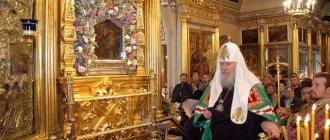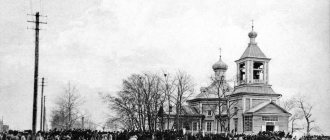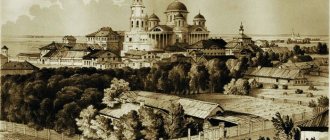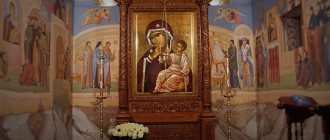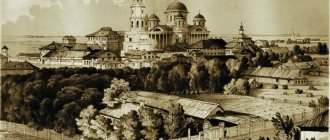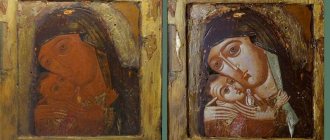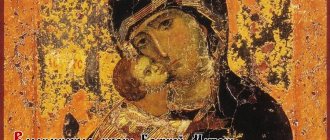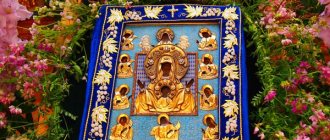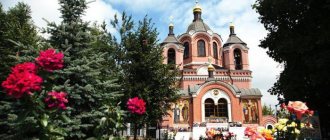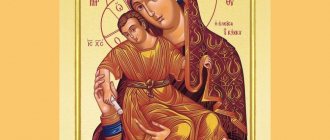History of the Abalatsk Icon “The Sign”
Abalak Icon of the Mother of God “The Sign”
(Abalatskaya, Abalatskaya-Znamenskaya), the most revered icon in Siberia. The name comes from the Tatar village of Abalak, located 30 km from Tobolsk.
The believing widow Maria, who lived in solitude at the Ablatsky cemetery, saw a dream in which the Mother of God appeared to her. She was accompanied by Saint Nicholas and Mary of Egypt. The voice commanded the widow to tell people about her appearance and to build a new church in honor of the Sign of the Mother of God. Due to her spiritual timidity, Maria told the Tobolsk Archbishop about the unusual dream only after the fourth apparition. The church began to be built.
At that time, the sick peasant Evfimy, who fervently prayed to the Mother of God for healing, promised an icon to the new church and ordered its painting to the protodeacon of the St. Sophia Cathedral of Tobolsk.
After the icon was completed, the peasant recovered completely. His prayers were heard, and the icon took its rightful place in the church. After this, the image more than once helped to heal the suffering who prayed to the Mother of God before it.
With the blessing of the Tobolsk Archbishop Nektary (Telyashin), the construction of the church began in 1636 and the icon of the Mother of God “The Sign”, Abalakskaya, was painted by the protodeacon of the Tobolsk Cathedral Matthew Martynov, commissioned by the peasant E. Koki, with whose recovery miracles of healing from the icon began.
Where did the name come from
Before talking about what the Abalak Icon of the Mother of God “The Sign” is, we should consider another image - the Novgorod one, because it was thanks to it that such a name was received. All icons of the described type refer to the canonical image of the Madonna Hodegetria. He raises his hands to the sky, holding his palms up in a prayerful pose, on his chest is an image of the unborn Christ who is still coming. This plot celebrates Christian virtues such as faith. Therefore, the Divine Child himself is not depicted here, but only a hint of his further aspect is given.
Such an icon was found in Novgorod in the second half of the 12th century, when other princes wanted to conquer the independent city. Then the archbishop of the city, Giovanni, received a sign and, following it, hung the icon on the city walls. An arrow shot by stormtroopers is stuck in the photo. Then the icon turned to the city, and myrrh flowed out. Those who were close to the city experienced inexplicable fear and began to retreat, and the Novgorod army was even able to pursue the attackers. The chronicler compares the icon and the stream of myrrh, which it helped with a “miraculous sign.” Hence the name.
In addition, many miracles have been recorded, including a cure for the plague in the mid-14th century. Icon painters began to compile lists that included the miraculous icon of the Abalak Mother of God “The Sign”; by the way, this name (sign) is characteristic only of Russian Orthodoxy, and in other countries the terminology is different.
Description of the Abalatsk Icon of the Mother of God “The Sign”
At this time, the original has not survived; the Abalatsk Icon of the Mother of God exists only in the form of copies made between the 17th and 19th centuries.
This icon can be recognized by Saint Nicholas (on the right) and Mary of Egypt (on the left) located on the sides. The icon itself is a skillfully painted image of the Mother of God. She raises her hands in a gesture of prayer, and on her stomach is the baby Jesus, folding his hand in a gesture of blessing.
The most famous version was made by the icon painter who did the original. This list is called the Abalatsk Icon of Semipalatinsk. It was created in the 17th century and was used to transport believers to other cities for worship.
Lists icons
In the XVII–XIX centuries. Many copies were made from the Abalak Icon of the Sign in Siberia, which were revered as miraculous.
Abalak Icon “The Sign” Semipalatinsk
- one of the most revered copies from the Abalak icon “The Sign”, probably executed in the 1st half. XVII century by the same icon painter to the extent and likeness of the original; this list was sent to Siberian cities and districts for veneration instead of the original icon.
In 1712, a copy of the Abalak icon “The Sign” was brought to a warship sailing from Tobolsk up the Irtysh. After the prayer service, which was served on the ship in front of the icon, the ship sailed “by itself” against the flow of the river and stopped when it reached the city of Semipalatinsk. The icon was placed in the city's Znamensky Cathedral; it was especially revered by the military. After the revolution of 1917, the cathedral was captured by renovationists, and even then precious parts of its decoration were removed from the icon. After the explosion of the cathedral in 1919, there is no information about the icon.
Abalak icon “The Sign” from the Krasnoyarsk Znamensky Skete
, an icon from the local row of the iconostasis of the Znamensky Skete - the copy closest to the original, made in 1887–1889. In Ekaterinburg. The miracles from this image are recorded in an inscription on an icon from the 10s. XX century “The Sign” of the Mother of God with a view of the Znamensky monastery, made by “(the care) of a tradesman.” Melnikova. (received) was freed (from) urine.”
The meaning of the Alabatsk icon
This image is very revered in Siberia. There, not far from Tobolsk, there is the village of Alabak, from which it got its name. The credit for finding the Abalatskaya icon belongs to a pious woman named Maria, who lived at the Abalatskoe cemetery. He had dreams in a row where icons, signs, and even St. Nicholas the Merciful and Mary of Egypt appeared.
As a result, the woman told the priest about this, and he, in turn, decided to organize and paint the corresponding icon in 1636. The customer of the icon was the peasant Koka, who was the first to recover from the sacred image. In addition, prayer in front of the icon of the Abalatskaya sign brought relief and consolation to many people and, of course, many miracles were recorded.
A significant number of copies were made from the same image, which were also considered miraculous. For example, the icon is in some churches, as well as in other cities of Siberia.
How does a miraculous image help?
Orthodox Christians pray before the image for the healing of various ailments. The icon has repeatedly shown miracles and helped people with severe forms of paralysis, eye diseases, and even those suffering from blindness to recover.
Each person asking must repent of his sins and realize the severity of his transgressions before the Lord. Our Lady of Abalatskaya is to this day one of the most revered icons of Siberia.
Prayer to the Mother of God before the icon
“Most Holy Lady Theotokos! You are a stronghold of purity and wisdom. We appeal to You in our prayers. Most Holy Virgin, save and preserve our lives, grant us healing from the ailments that consume us. Don’t let us fall away from illness and weakness, accept our prayers and bring them to the Lord. We repent of all our misdeeds and sins that we have committed. We humbly bear the cross of physical burden and illness, but we pray for forgiveness and salvation. Amen".
Anyone can resort to Divine help in difficult times. Prayers have saved people from unpleasant situations more than once.
Troparion to the Most Holy Theotokos before the Icon of Her “The Sign” Abalatskaya
voice 4
As an insurmountable wall and a source of miracles/ Your servants,/ Most Pure Mother of God, who have acquired You,/ we overthrow the opposing armies./ Moreover, we pray to You:/ grant peace to Your city// and our souls we give you great mercy.
Kontakion of the Most Holy Theotokos before the Icon of Her “The Sign” Abalatskaya
voice 4
The honorable image of Your sign / celebrating Your people, Mother of God, / in which You bestowed a wondrous victory against Your city. / Moreover, we cry to You by faith // Rejoice Hey, Virgin, Christians are praised.
MIRACLE WORKING
About twenty years ago I had the opportunity to read a study by an Omsk writer about the Abalatsky monastery near Tobolsk. And they talked there about the amazing Miraculous Icon of the Mother of God. To the right of the Mother of God it depicted the saint and wonderworker Nicholas, to the left was Mary of Egypt. This icon received its greatest fame and glory after touching it, the already dying ten-year-old son of the governor of the Tobolsk province, Prince Gagarin, was healed. In the twenties of our century, the Miraculous was irretrievably lost; a copy of it ended up in Australia.
For many years I could not get this icon out of my head. In March 1995, I decided to try to find her with the help of Nizhnevartovsk clairvoyant Olga Gurbanovich, of whose amazing abilities I was convinced many times.
Olga reported that the icon is intact; it is located in a remote village in the south of the Tyumen region with a 90-year-old grandmother who is a healer. People come to her from afar, they are truly healed, but, alas, it is not the granny who heals, but the icon, which her current owner does not even suspect. Olga said that the icon should not be touched, the time had not yet come for her. But it is possible to heal. In this case, it is not necessary to have it in front of you; it is enough for the sufferer to close his eyes, imagine the image of the icon in front of him, read the Lord’s Prayer (“Our Father…”) three times mentally or out loud and ask the Mother of God for healing.
I decided to conduct an experiment and published an image of the icon and the above text in one of the monthly magazines. And what do you think? Letters have been sent. Here’s the first one: “For many years my arm hurt, my elbow joint was damaged. And although the pain was so strong that I dulled it with strong analgesics and psychotropic drugs, I did not go to the doctors (I don’t believe them). Finally, the arm completely stopped bending, so even washing my face in the morning became a chore. That’s when I applied the image of the Abalatskaya Mother of God to the sore spot. And the pain disappeared, and after two days the hand began to move easily. Now I treat all my family and friends with this icon: for someone to relieve a migraine, for someone with a stomach spasm. Always helps. And the other day I had a chance to cure a cow. The neighbor's cow started having mastitis after giving birth, her udder was swollen, and every milking was a real ordeal for the animal. I applied the icon to her udder, and by morning the inflammation had passed. May the Lord and the Mother of God forgive me for my attempt to heal the cattle with their help. So I almost never part with the icon, I cut it out and pasted it on cardboard; for me it is a priceless treasure.”
Unfortunately, this woman from the Donetsk region asked not to indicate her first and last name.
Here's another letter:
“Thank you very much for the Holy Mother of God and for your work, which is very necessary for people. I couldn’t hear in my left ear for two years, I thought it was my age (I’m 84 years old), but now I hear well. What a joy! Good health to you. Sincerely. Nadezhda Stepanovna Zakhlypina. Krasnodar city".
A miracle happened! The monthly three times (!), at the request of readers, published publications on the Abalatskaya Mother of God.
I am sure that a real image of the icon will definitely help you. You just need to believe!
Mikhail Rechkin
Day of celebration of the miraculous icon of the Mother of God
Orthodox Christians celebrate the icon of Our Lady of the Sign twice a year: on August 2 and December 10 according to the new style. On these days, solemn services are held in churches, and every believer reads prayers for salvation, protection and healing.
Since 1665, an annual religious procession was established, when the miraculous icon “The Sign”, with a huge crowd of pilgrims, was transferred to Tobolsk and remained there from July 8 to 23. In 1680, the wooden church in which the holy icon was located burned down, but the miraculous image was saved .
On the site of the church, the stone Znamensky Cathedral was later erected, and in 1783 a men’s monastery was founded in honor of the icon of the Mother of God “The Sign”, which existed happily until the beginning of the 20th century. The Abalatsk image of the Mother of God was especially revered by the royal passion-bearers; they prayed before her during Tobolsk conclusion.
In 1924, the monastery was closed by the atheistic authorities. Only in 1989 the monastery with the destroyed churches was returned to the Tobolsk diocese of the Russian Orthodox Church. However, the original Abalatskaya Icon of the Mother of God is not found either in the monastery or in Tobolsk. Traces of her have been lost, and her current whereabouts are unknown.
In the monastery being restored from the ruins there is one of the copies from the prototype, which according to ancient tradition is called the “Vicar”, and from which miracles of healing now occur for those who resort to the help of the Queen of Heaven.
Literature
- Notes on Siberian history // Ancient Russian Vivliofika. M., 1788. T. 3. P. 157–159;
- Abalak miraculous icon of the Mother of God. Tobolsk, 1836 (and last edition);
- Berezin Z. Abalatsky monastery and the miraculous icon of the Sign of the Mother of God. Kazan, 1848;
- The Legend of the Icon of the Mother of God, called Abalatskaya. M., 1849;
- New blessed apparitions from the Abalatsk Icon of the Mother of God. Omsk, 1879;
- Sulotsky A., prot. The legend about the icon of the Mother of God, called the Abalatskaya and about the most important copies from it, with the image of the Abalatskaya icon of the Mother of God. 6th ed. Tobolsk, 1888;
- Aleksinsky D., priest. A short story about the miraculous icon of the Mother of God, called Abalatskaya, about the miraculous copy of it, located in the city of Semipalatinsk, and about the holy spring. Semipalatinsk, 1900;
- Soloviev A. The Holy Icon of the Mother of God, called Abalatskaya. Her list is in the Semipalatinsk Znamensky Cathedral. Sergiev Posad, 1909;
- The Mother of God: A complete illustrated description of her earthly life and the miraculous icons dedicated to her name / Ed. E. Poselyanina. St. Petersburg, 1909. pp. 735–739, 744–745;
- The legend about the icon of the Mother of God, called Abalatskaya, in the village of Protopopovsky, Tobolsk district. Tomsk, 1913;
- SKKDR. St. Petersburg, 1992. Issue. 3. XVIII century Part 1. pp. 317–318;
- Yuryevsky A. A rare monument of Siberian spiritual writing of the first half of the 17th century // Tobolsk A.A.. 1902. 24. P. 447–464;
- Romodanovskaya E.K. Russian literature in Siberia in the first half of the 17th century. Novosibirsk, 1973. pp. 139–140;
- Pivovarov B. Heavenly patroness of Siberia // ZhMP. 1991. No. 7. P. 35;
- Siberian icon: Album. Omsk, 1999.
Vivat Kolchak!
In 1785, when the old wooden church in Abalak had already become quite dilapidated, a new stone church was built in its place and a monastery was established, the main shrine of which was the miraculous icon. By those years, the Abalak Mother of God was already known throughout the Russian Empire. Moreover, even members of the royal family came to bow to her. So, in 1891, she made an indelible impression on Nikolai Alexandrovich Romanov (the future Emperor Nicholas II), who came to Tobolsk during his trip to Asia. Later (in 1917), while staying here in exile with his family, the abdicated emperor wanted to venerate the miraculous image, but the jailers did not allow him to do so. Then, in one of the city’s icon-painting workshops, a special list of the Abalak Mother of God was created for the royal martyrs, which was with them until the execution in Yekaterinburg. In the fall of 1918, the image was transported from the monastery to Tobolsk, and it was never destined to return. This happened on the orders of Admiral Alexander Kolchak, who liberated the city from the Red troops. Later, the icon moved with him to Omsk, which for some time became the capital of Siberia, freed from the Bolsheviks. There, the Abalak Mother of God was placed in the Assumption Cathedral, and it was at this image that in January 1919 Alexander Vasilyevich took the oath as the Supreme Ruler of Russia. However, a few months later, Kolchak’s troops suffered a crushing defeat from the advancing Red Army, and in November 1919, Soviet power was re-established in Omsk. Since then, the image of the Abalak Mother of God has been considered lost.
